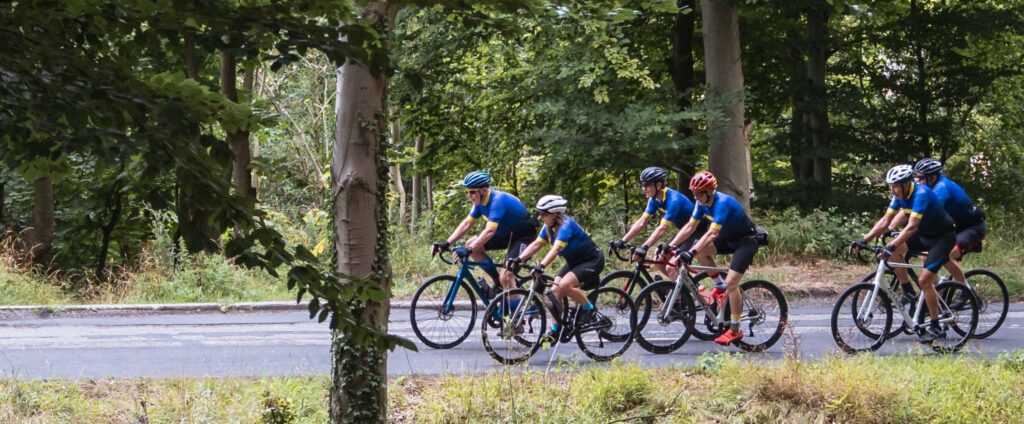
Great news – you’ve joined BCC and you’re coming on a club ride! We are rightly proud of our friendly and inclusive club and the weekly Saturday club ride is its heart and soul. To get to this point, we assume you’ve got a bike, are confident riding it and have perhaps ridden with friends or in events like sportives. So why do you need to find out about group riding and its etiquette? The answer’s simple. You’ve decided to join a group ride and although this includes elements of a training ride, catching up with or making friends and exploring the countryside, it’s also a chance to work on the skillset and enjoyment of group riding.
Some of the things that you will experience on your group riding journey :
- Working as a team, co-operating and communicating so you all ride better and enjoy more
- Riding in a compact group, following another wheel and drafting so you ride stronger for less effort.
- Matching your pace to the others in the group so that you all work together efficiently.
- Riding alongside another group member with handlebars lined up and having an interesting conversation.
- Keeping your concentration on the road so you can spot and communicate hazards to help everyone have a safe ride
- Sharing your experience or supporting when others have a mechanical.
If you’re still not convinced, see what GCN have to say about it.
The Basics
- Follow the Highway Code and ride safely. Specific cycling rules 59 to 82 and 211 to 213.
- Prepare for the ride with a well maintained bike including pumped up tyres.
- Carry enough food, water and spares to support punctures and other mechanicals.
- Always wear a helmet.
- Fit mudguards during the winter.
- Carry a form of ID that includes an emergency contact (e.g. your British Cycling card)
Etiquette
- Ride in your defined group. Be aware how many are in your group and try not to get mixed up with other groups. If leaving the group (e.g. to take a different route home), communicate clearly with other group members.
- Stick to the appropriate pace for the group on today’s route and today’s conditions.
- All club rides are no drop. If you notice someone has been dropped, communicate to the group and ease up or wait for them.
- Groups should have a maximum of 10 riders.
- Encourage and support each other.
Riding in a group:
- Pay attention to the road, other traffic, the group and the route.
- Aim to be 0.5 – 1 metre behind the rider ahead of you.
- Consider road and traffic conditions; the group may ride in a single line or in two lines.
- If the group is riding in pairs, keep your handlebars in line with each other matching your speeds.
- Groups should ordinarily ride together but riders may choose to briefly ride at their own speed on steep climbs or on descents.
- Be predictable! Ride carefully and consistently: hold your line, keep your position in the group, keep a steady pace, pedal smoothly and don’t surge, don’t grab your brakes
- Ride to effort, not speed: faster on the flat – slower on the hills.
- If you come to the front of the group, take over at the speed of the previous leader rather than increasing the group’s speed.
Communication:
Don’t worry about learning or getting these exactly right, the most important thing is that you do communicate. Common hand gestures and calls include:
- Obstacles – “hole”, “gravel”, “horses”, “walker” – the call may be accompanied with pointing to its location.
- Downward point to the right or left – Pothole, manhole cover or broken road.
- Palm down hand shaking – gravel, broken or uneven surface.
- “Car front” / “Car back” – a vehicle is approaching.
- Point behind back – over-taking a stationary vehicle or obstacle in the road.
- “Slowing” or ‘stopping’ – if possible called before the rider starts slowing / stopping.
- “Mechanical” – someone has had a mechanical incident and needs to stop to fix it.
- “Clear / Clear left / Clear right” – at a junction, to indicate it is clear of traffic (but don’t rely completely on this – traffic moves quickly).
- “Single out” or “Pair up” – the group should ride in a single or a paired line.
- “Easy”, “Ease up” or “Soft Pedal” – the group should ease their pace, perhaps because riders need time to catch up.
- “On your left” / “On your right” – as you’re approaching a rider from behind.
- “All on?” – a question to check if the group is back together, for example after a junction.
- “Behind you!” or similar greeting – to alert walkers or horse riders. When passing horses slow down and give plenty of warning.
It’s important that comms are passed up and down the group – you may need to pause your chat/conversation to do this.
